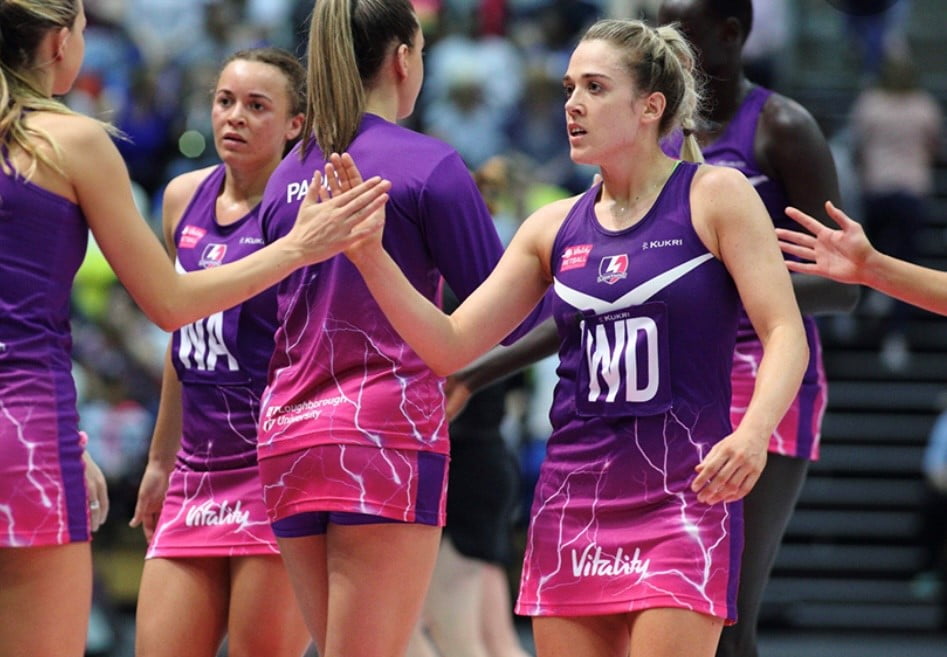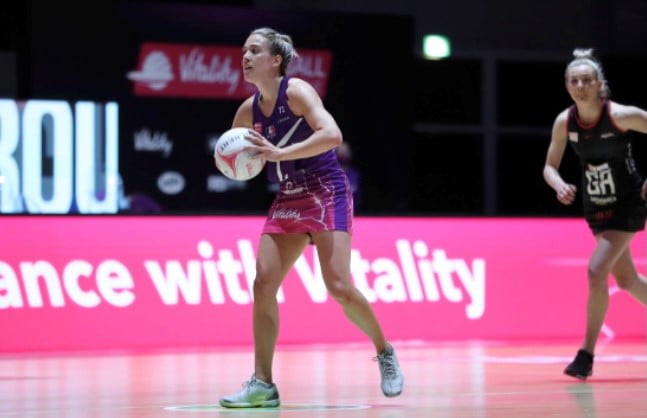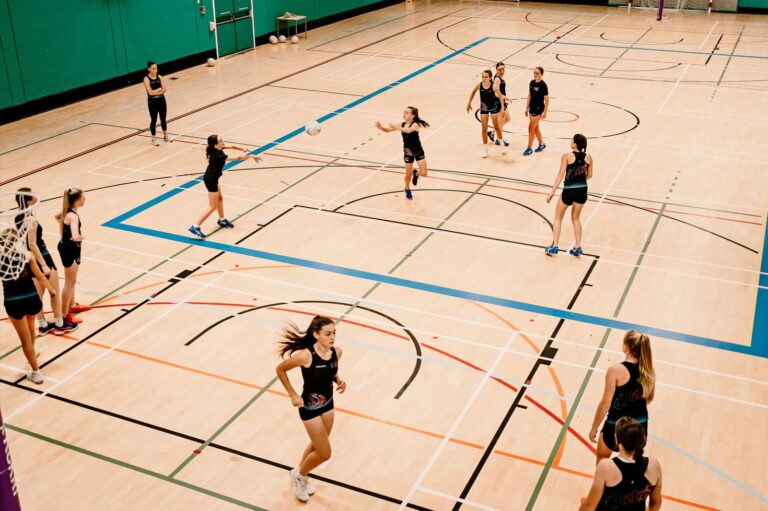Netball Defence Drills
As a defender in netball, the aim is simple, to gain possession of the ball from the opposing team. This can be achieved through an interception, forcing an error or a held ball.
Nat Panagarry believes defending is one of the hardest skills in netball. It is something that she constantly works on in training. It’s important to remember that every player on the court is a defender (and every player is an attacker!). The best teams in the world have a full 7 who contribute to both while on the court.
Below Nat delves into netball defence skills and types of defence plus looks at three players to watch and learn from.
Contents:
- 5 skills defenders need
- Coaching points when working on defence
- Types of defence
- Netball defence drills
- Netball defence drills to do by yourself
- 3 world-class defenders to watch
What’s your superpower?
Everyone has their own super strengths on the court and all defenders have different styles. Are you someone who’s got good elevation to pick off those high balls? Or are you someone who can challenge the flat quick passes or maybe you are someone who communicates with others really well to shut down attacking play?
Defending well can look very different. So find your strength and keep working on it!
Positioning in defence is really important as you need to be able to read the play around you and dictate your opposition while making sure you’re ready for any opportunity to intercept the ball.
The 3 stages of defence
Stage 1 – Marking the player
- Keep close to your opponent
- Try to be ball side, forcing your attacker back up the court away from their shooting circle
- Take on a side approach so you can see the attacker and also the ball
- Standing slightly in front at a 45-degree angle can work too
- Make sure you’re on your toes and your footwork is ready so you can react to the passes or movements around you
Stage 2 – Marking the ball
This is when your attacking player has received the ball and you’re trying to make it difficult for them to pass the ball on by restricting their options. There’s also a chance that you can intercept the ball once it’s been thrown in the air.
- Your feet should be 3 feet away from the attacking player’s landing foot
- Go up onto your toes for more height
- Keep your arms and hands outstretched over the ball, not to the sides (and remember to get your distance before your arms go up!)
- Communicate with your team – players should call out to each other to move left or right to help intercept the pass
- If elevation is your strength, you may want to jump when the player passes or shoots to see if you can get a deflection

Stage 3 – Marking the space
- Timing
- Peripheral vision
- Where the attacking players are and standing in the space they want to go so you’re not right on the body. This style of defending means you’re less likely to get blown for obstruction by the umpires
- Anticipating the pass by reading players’ body language and running your feet through the line of the ball for the interception
5 skills netball defenders need
- Position well at the start
Angles in defence are really important. You want to make sure you’re dictating the space and forcing your player high and wide away from their shooting circle. Use the sidelines to your advantage and limit the attacker’s space. Standing on the side of attackers and dictating early can put a lot of pressure on attackers and won’t allow them the space they want.
Always try and force attackers to the non-ball side, so if the ball is given, it spends more time in the air allowing you to challenge.
- Watch the player and the ball
Your head and eye position are really important in defending. You need to be able to see not only your attacker but also the ball/everyone around you. This is one of the hardest things about defending. You can be in the correct space but if you don’t have your eyes up to see the ball, you won’t be successful.
- Quick feet and reactivity
Your footwork is one of the main skills in defending. Moving quickly will not only help to give you more opportunities but also help you tire out your opponent if you’re able to constantly challenge and reposition your footwork around them.

- Attack the ball with two hands
Sometimes you can be in the right space and challenge for the ball however your timing can be off and you contact your attacker. This is because you’ve gone too late onto the ball or you’ve gone for the interception where the ball was going to land instead of running your feet and meeting it earlier. Defenders who run their feet at full speed and go with two hands are always likely to be more successful.
- Be confident and communicate
Defending in netball is all about being confident on the court and asserting yourself. Don’t be afraid to hassle the attacker to put them off their game and hopefully get them to make mistakes. The louder you are with players around you, the stronger the defensive unit.
Coaching points when working on defence
Footwork
Good footwork is one of the main attributes of being a good defender in netball.
Whether it’s moving around the body of the shooter in the circle to avoid becoming stuck on a hold, reacting to a high ball and moving quickly to intercept it, or quickly responding and shutting down an attacking move on a centre pass, it’s really hard to do any of this well without having great footwork.
- Keep reminding players to be on their toes and light on their feet
- Don’t have their base too wide. This will stop them from being flat-footed
Body position & vision
Whilst defending, you should always try to maintain an open body position, allowing you to see both the player and the ball.
- Good angles on the 45
- Head and eyes up
- Arms down when moving with your attacker
Arms
The aim is to restrict the vision of the opposing player who is in possession of the ball and make it harder for them to pass and release freely
- 3 feet from the player with the ball
- On your toes and knees bent ready to jump or step back up to your attacker
- Arms up over the ball and fingers spread
- Body weight is slightly forward
Types of defending in netball
The main types of defence that we use at my club are one-on-one, zone and box defence.
One-on-one defence
This is the main style of defence that a lot of Superleague teams use in the UK. This is where players take responsibility for their own players, tracking their movement on their own in isolation. This style of defence is used a lot when teams are setting up their centre pass defence, backlines and sidelines on the court. It’s one of the quickest defence styles to fall into for the 7 that are on the court and can be the most effective. It requires a lot of work rate/intensity and if attacking teams don’t like constant contest and hustle this is the perfect style to do against them.
Zone defence
Zoning is a really effective defensive strategy if it’s done well. It’s a defensive technique where the whole team come off the body and mark the space instead of the player, usually in the centre of the court. If the ball or a player enters their space, it then becomes their responsibility to intercept or slow the player in that area. It is great for the team to work together for a central aim – to win back the ball.
However, when a zone isn’t done well and the 7 on the court are not doing the same thing, attackers can take a huge advantage and move quickly through the zone to their shooters. You will see Superleague teams set up zones from the opposition’s backline and throw-ins as a change to their normal structure. They want the element of surprise to be their advantage – they are trying to make their opposing players go on long drives around their zone or across court balls that are longer in the air to challenge.
Communication is key to the success of full-court zone defence in netball – each player should be communicating with the ones closest to them. The noise teams make whilst putting on a zone can also be a reason attacking players force an error.

Box defence
This is a very similar structure to a zone however it’s just the back 4 in the attacking 3rd that will put this on. So we’re talking about the GK, GD, WD and C.
As a back 4 unit, they will stand in space in a box shape, protecting the middle of the 3rd. Again this is all about communicating, confidence and challenging the ball around you while being off the body.
Back 4’s will put this on in Superleague maybe from a sideline in the attacking 3rd or drop into this structure after a centre pass. If a few defensive players have been catching the attention of the umpires it’s a good way to stay off the body and work as a unit. Similar to the zone, forcing attacking players on longer drives towards the sidelines or away from each other, so defensive players have more time to challenge the ball in the air.
Netball Defence drills
Defending requires you to make decisions about your opponent’s movement and the pass that is coming in. Defensive drills should focus on this.
Netball Defence drill 1 – shadowing
It is important at training to practice a good defensive body position, reacting to where the attacker wants to go and dictating their movement into uncomfortable positions while on the move.
1 defender, 1 attacker, 1 feeder
Working at 50%, the attacker can move forward and back between two cones. The defender has to shadow them and keep a good body position, quick footwork and keep their head in the same position. After 10 seconds, the feeder shouts GO, the attacker has to get free for the ball in 3 seconds. Can the defender keep forcing the attacker into the space they want or do they let them go where they want? Reset and go again.
Netball Defence drill 2 – Challenging the ball
Once players have mastered their body positioning and moving effectively with their opponent, it’s now about them practising challenging the ball. Having the confidence to run their feet and challenge with two hands cleanly.
When coming forward to intercept, look for players to attack the line of the ball at its earliest possible point to avoid contacting their opponent.
2 Feeders, 1 Defender
A figure of 8 drill
Defenders work their feet and complete a figure of 8 movement around their feeders timing their interceptions between the two feeders while they pass to each other.
Progression –
Add 4 cones around the feeders – Defenders work their feet around the cone before challenging the ball to intercept.
Then you can add an attacker to the side of the feeders, can the defender shadow and stay with their player. Shut down that pass and then come off their attacker to intercept the ball from the feeders.

Netball Defence drill 3 – Communicating and Working with others
The next stage players can practice at training if they are successful at working in isolation, is now how they work with others around them. Can they position themselves to see other attackers to switch or drop to become more effective defence units?
2 attackers, 2 defenders
In half a 3rd, make the attackers pass the ball between them from one third line to the opposite line. This allows the defenders to practice a 2 vs 2 scenario, times when they can work in isolation on 1 v 1 or are there opportunities to force the attackers together and switch? This is also a great opportunity for older players especially to work on their communication. Defending is all about presence, the louder they are the more successful they will be. It puts doubt in the attacker’s minds and makes sure, as a defensive partnership, they know their roles and what they want from each other. Are they staying on their own, are they switching, are they dropping, or are they giving each other positive feedback to challenge the ball as they back each other up?
Netball defence drills to do by yourself
The most productive netball defence drills you can do by yourself are footwork drills. The more footwork patterns you do at max speed, the more success you’ll start to see on the court.
Netball Footwork Drills and Patterns
Any set-up that helps you practice quick feet, short reactionary steps and sharp changes of direction will put you on the right track.
Cone drills or cone and ball drills that incorporate quick forward movements, followed by backward movements or defensive side steps, as well as quick feet around cones – figure of 8 style are a good place to start.

Timing can be an issue for some defenders, you are either coming in for the interception late meaning that you knock into the attacker or you are not getting your feet around the player quick enough meaning that you are challenging on the body and getting called by the umpire.
At home, you can do ball and wall drills to practice using your outside arm and getting your feet around objects so you can challenge cleanly. For example:
Grab yourself a chair, cone, bin or anything you can stand in front of. Bounce the ball and get around the object before receiving the ball again. Practice keeping your foot base small, using quick feet and trying to take the ball with your outside arm or two hands. You can then progress this to starting a little behind your chair or cone passing the ball against a wall and then driving forward at speed to intercept in front of your object.
Make sure you practice this on both sides and running onto the ball around your object, don’t wait for the ball to come to you!
3 defenders to watch from NSL, SSN or ANZ
There are so many players across the three leagues that I love watching and I love figuring out everyone’s defensive strengths. The three below are incredible and have such talent for winning the ball cleanly and in their own way:
NSL – GD Funmi Fadoju
SSN – GK Courtney Bruce
ANZ – WD Kate Heffernan
I hope you’ve found this blog on netball defence drills useful.
Nat x







